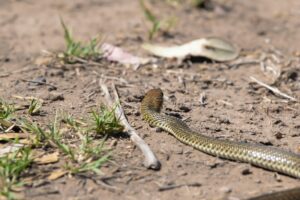With Spring mating season underway, snakes are becoming more active and the warmer weather is starting to draw them into homes and backyards. So, it’s important to stay aware and if you do see a snake, ensure your family and pets are well out of harm’s way.
Most snakes, with exceptions like the eastern brown snake and the coastal taipan which have a greater tendency for aggression, are only too happy to slink away from animals too big to serve as their prey. However, dogs are curious and playful – some are born hunters – which unfortunately means they may harass a snake and provoke it into an attack.
If you see your dog actually being bitten, you know what you have to do: get your pet to a vet fast. This is more important than trying to recognise the type of snake because:
what you have to do: get your pet to a vet fast. This is more important than trying to recognise the type of snake because:
- you could put yourself in danger
- vets can use a kit to identify the species of snake from its venom
- snake-specific antivenoms are preferable but polyvalent ones will be used anyway unless identification is certain
If your dog was wandering alone around your garden or in the bush, you may not even be aware that an encounter with a snake has taken place – that is, until your dog starts displaying symptoms which set alarm bells ringing. The symptoms may take anywhere from immediately to about a day to manifest themselves, depending on a variety of factors, such as:
- the species of snake
- the size and age of the snake
- whether some of the snake’s venom has been discharged by an earlier bite
- the season – snakes tend to have greater stores of venom shortly after hibernation
- the size, age and state of health of your dog
- the part of your dog’s body which was bitten
The above criteria are also critical in terms of whether your dog will make a full recovery or not.
The symptoms to be aware of include:
- sudden onset of weakness developing gradually into an inability to stand
- muscle twitches or shivering
- vomiting
- bright red colouration of the gums or around the irises
- dilated pupils which don’t respond to light
- blood in the urine
The clincher as to whether these symptoms were actually due to a snake bite is if the tell-tale puncture wounds made by the fangs can be found on your dog’s body – typically its head or front paws. But faced with such grave health concerns the default must always be to rush your dog to the vet, keeping them as immobile and calm as possible in order to lessen the spread of the venom.
Once your dog is in the hands of the vet, you can be certain they’re in the best possible place and there’s usually nothing more for you personally to do other than wait. You may not know for certain what the outcome will be for at least 24 hours, but a high percentage of dogs who receive treatment will go on to make a full recovery.
Now you know the warning signs, please keep safe with your dog this snake season and have a plan in place in case of an emergency.